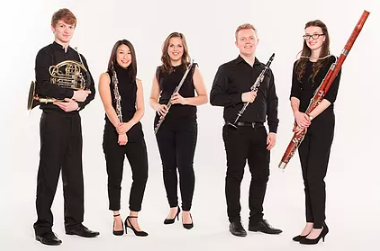Dodgson (a distant cousin of Lewis Carroll) was the son of the Symbolist painter John Arthur Dodgson. After being conscripted into the Royal Navy during World War Two, Dodgson studied privately with Bernard Stephen and then with R. O. Morris, Patrick Hadley and Antony Hopkins at the Royal Academy of Music. He won the Cobbett Memorial Prize for a Fantasy String Quartet in 1948, and two Royal Philharmonic Society prizes, in 1949 and 1953. He started teaching at the Royal College of Music in 1956, becoming professor of composition and music theory there in 1965 and remained in the post until he retired in 1982.Margaret Catchpole was commissioned by The Brett Valley Society for the Arts and the first performance was in Hadleigh, Suffolk in June 1979. The librettist was Ronald Fletcher (1921-1992) who based on Richard Cobbold’s 19th century novel about Margaret Catchpole. The opera was revised ten years later for the Wangford Festival in Suffolk. The original commission determined the work’s need for practicality (it uses an instrumental ensemble of 11 players and there is no chorus) as well as suggesting the Suffolk-based subject matter. Dodgson’s wife, the harpsichordist Jane Clark, was a Suffolk woman and possessed a copy of Richard Cobbold’s 1845 novel which vastly embroiders a true story.
The basic facts are that Margaret Catchpole, a Suffolk servant girl, was obsessed by a smuggler, William Laud, and stole a horse to get to London to be with him. She was transported to Australia, and her chronicles of her time in Australia are an important documentation of the colony’s early history.
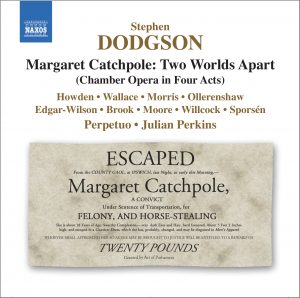 The opera is less interested in Margaret the chronicler and more in Margaret’s obsession. Act One introduces us to Margaret and her ne’er-do-well smuggler lover, as well as local farmer John Barry who is in love with her. At the end of Act One, Laud has refused to marry Margaret and has wounded Barry. By the end of Act Two, still obsessed by Laud, she is tricked into stealing the horse. Act Three features the court-room along with Margaret and Laud’s attempt to escape which is foiled and Laud is killed. Act Four is more of an Epilogue in Australia, when Margaret is on her way to being pardoned and is re-united with John Barry.
The opera is less interested in Margaret the chronicler and more in Margaret’s obsession. Act One introduces us to Margaret and her ne’er-do-well smuggler lover, as well as local farmer John Barry who is in love with her. At the end of Act One, Laud has refused to marry Margaret and has wounded Barry. By the end of Act Two, still obsessed by Laud, she is tricked into stealing the horse. Act Three features the court-room along with Margaret and Laud’s attempt to escape which is foiled and Laud is killed. Act Four is more of an Epilogue in Australia, when Margaret is on her way to being pardoned and is re-united with John Barry.
For all the work’s ostensible practicality, there is something wonderfully impractical about Dodgson and Fletcher’s opera.
For a start, it is in four acts with just shy of three hours of music which means that the opera probably needs getting on for four hours in the theatre. The four acts are also quite leisurely, Dodgson and Fletcher tell the story with an eye for colourful incident, but there are times when you feel it could have moved faster.Part of the reason for this leisurely feel is that only Margaret herself appears in all four acts. Her two swains, Laud and Barry, crop up at various points through the opera as does the fisherman Crusoe, but each act very much has its own location and set of characters so that in addition to the four leads there are ten further named characters plus two labourers. The score’s listing on the Stephen Dodgson website suggests using a considerable amount of doubling, reducing the cast to nine (plus the two labourers). Probably quite sensible, the recording uses almost no doubling so that there is a cast of 13 plus two labourers.
For the opera to work, we have to care for Margaret and her love for her ill-fated smuggler Will. Now, I have to admit first off that whilst I had great sympathy for her and found Kate Howden’s performance very appealing and ultimately rather moving, my principal reaction to the character was to want to give her a good shake. But then there are plenty of other characters about which I feel like that in opera, such as Manon in both her incarnations.
Dodgson’s style is what one might call Britten-esque, and he writes in an aptly chamber style using his voices and instruments as one large chamber ensemble. This is a piece full of delightful textures. He is also careful about text, so much of the opera is in arioso-like recitative, ensuring we can follow yet the textures Dodgson creates mean that we enjoy the result. There are chorus-like pieces too, so that some of the men gather together in Act One to bring in the harvest, singing a folk-like song.
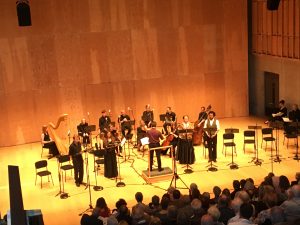
Act 2 – Margaret Catchpole semi-staged performance/recording
Act One introduces us Margaret, her lover Will Laud and her admirer John Barry, and ends up with the drama of Laud attempting to kill Barry. In Act Two, the drama of Margaret and Will’s difficult relations continue, But whilst Howden gives a terrifically intense performance here, the drama seems a little slow to catch fire. And Wallace makes a wonderfully rough-edged Laud, though the two never quite meet in this Act which is something of a shame in terms of the way the two characters manage to be both obsessed with each other and yet rub each other the wrong way.In Act Three we have two court scenes, separating Margaret and Laud’s attempt to escape which culminates in Laud’s death, but the main musical weight is carried by a pair of moving soliloquies for Margaret, powerfully sung by Howden. Act Four is rather quieter, with thoughtful solo for Margaret, whilst Barry and Margaret’s reconciliation is realistically low key and much of the emotional weight is carried by the instrumental interlude. (I am afraid I had a heretical thought, and wondered whether we needed this act at all, and whether musically it might make more sense to end with Margaret’s powerful solo which concludes Act Three just before her transportation.)
Throughout the more subsidiary characters make the most of their moments, giving us a series of vivid cameos. Nicholas Morris’ Luff is wonderfully plausible and dubious, whilst Richard Edgar-Wilson makes a lively Crusoe, both of them dubious characters. Diana Moore is nicely sympathetic as Margaret’s employer in Act Two. Matthew Brook makes a delightfully pompous, albeit sympathetic, Judge in Act Three, and in Act Four, Julia Sporsen make the most a role which is full of character yet seems to hold up the action. There is strong support from Peter Willcock, Jon Stainsby, Robyn Allegra Parton (who pops up in two contrasting supporting roles), Michael Bundy, and Leonora Dawson-Bowling.
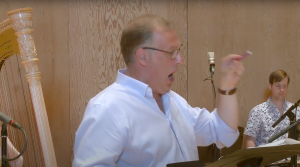
Matthew Brook’s judge passes judgement in recording
There is a lot of felicitous detail in the work, and Dodgson has a nice ear for characterisation, and the singers clearly all relish the opportunities that the opera gives them. To enjoy the piece, I think that you have to think less about the progress of the drama and more about the richly drawn scenes unfolding before you.
Throughout, Dodgson links his scenes with atmospheric orchestral interludes which greatly add to the interest of the opera, and Perkins gets fine performances of these from the members of Perpetuo. These interludes partly contribute to the work’s leisurely feel, but yet they are musically so strong, and Perkins and his players make them an integral part of the opera.
The set does not include a libretto, but there is a detailed synopsis and the singers’ diction is excellent which means that you hardly need a crib to follow the action.
The work is firmly a Suffolk opera, and all performances so far have been within the county, so it remains to be seen whether the work’s other aspects can gain it some traction on the wider national and international stage. It should be pointed out that Dodgson is also competing with another Suffolk opera, Britten’s Peter Grimes, and whilst the two are different works there are elements in common, a rough, misunderstood seagoing man as leading male character, a doomed love affair between him and the heroine, and scenes in Ipswich magistrate’s court.
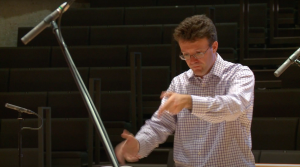
Conductor Julian Perkins
The recording is notable for the vividness of the performances and the tidiness of detail in a contemporary piece is admirable. Dodgson’s final opera has full justice done to it on disc. Whilst I enjoyed the work, and found much to appreciate in the opera and in Dodgson’s music, I have to confess that throughout the piece I was constantly thinking about all the little nips and tucks that could be done to the piece, moments when making the action flow somewhat faster might improve things. That said, it would be interesting to experience the work on stage, if only to prove me wrong. With its plethora of small but rewarding characters, you can’t help feeling that this is a work that could be taken up by music colleges.Stephen Dodgson (1924-2013) – Margaret Catchpole: Two Worlds Apart (1979) [2:55:48]
Margaret Catchpole – Kate Howden (mezzo-soprano)
Will Laud – William Wallace (tenor)
John Luff – Nicholas Morris (bass)
John Barry – Alistair Ollerenshaw (baritone)
Crusoe – Richard Edgar-Wilson (tenor)
Mrs Cobbold – Diana Moore (mezzo-soprano)
Dr Stebbing – Peter Willcock (bass)
Judge – Matthew Brook (bass)
Mrs Palmer – Julia Sporsen (soprano)
Guard – Jon Stainsby (baritone)
Alice/Lucy – Robyn Allegra Parton (soprano)
Farmer Denton – Michael Bundy (bass)
Mrs Denton – Leonora Dawson-Bowling (mezzo-soprano)
First labourer – Jonathan Hanley (tenor)
Second labourer – Mark Saberton
Perpetuo
Julian Perkins (conductor)
Recorded at the Britten Studio, Snape Maltings, 5-7 July 2019
NAXOS 8.660459-61 3CDS [45.52, 47:49, 82:07]






